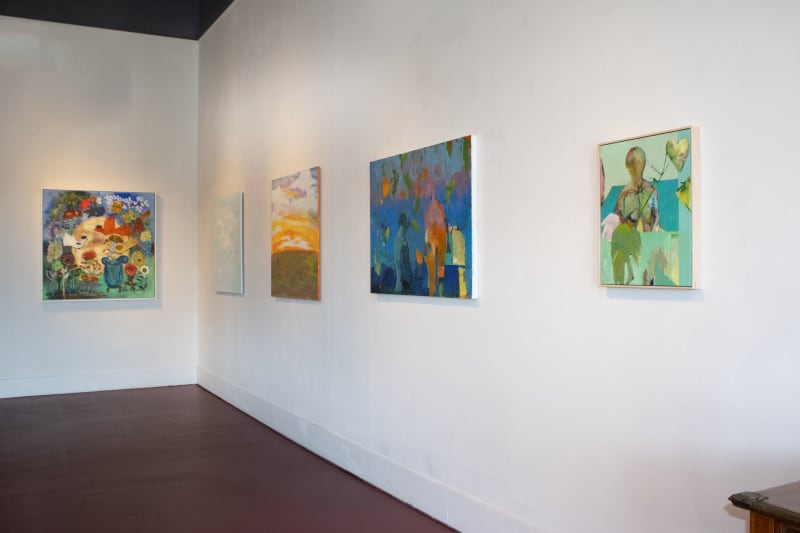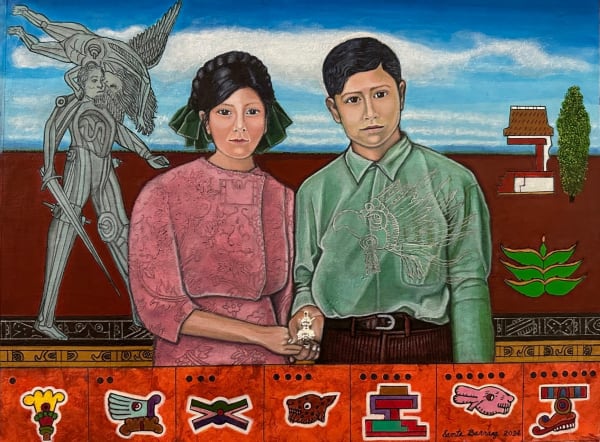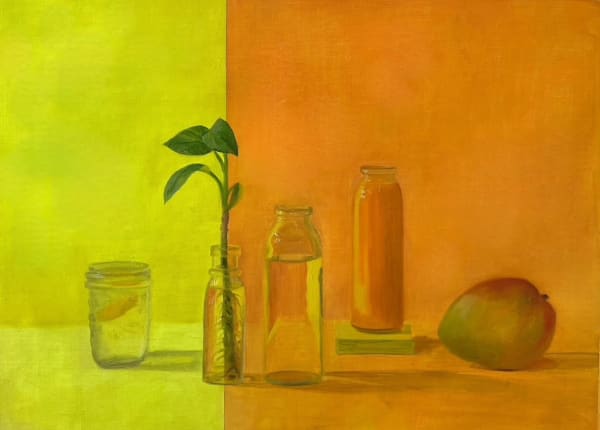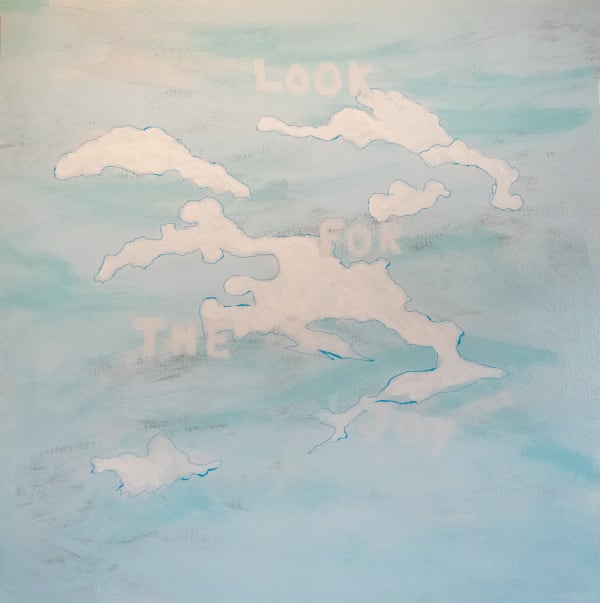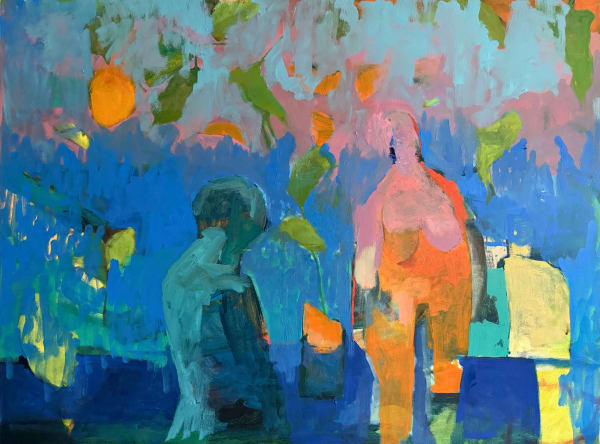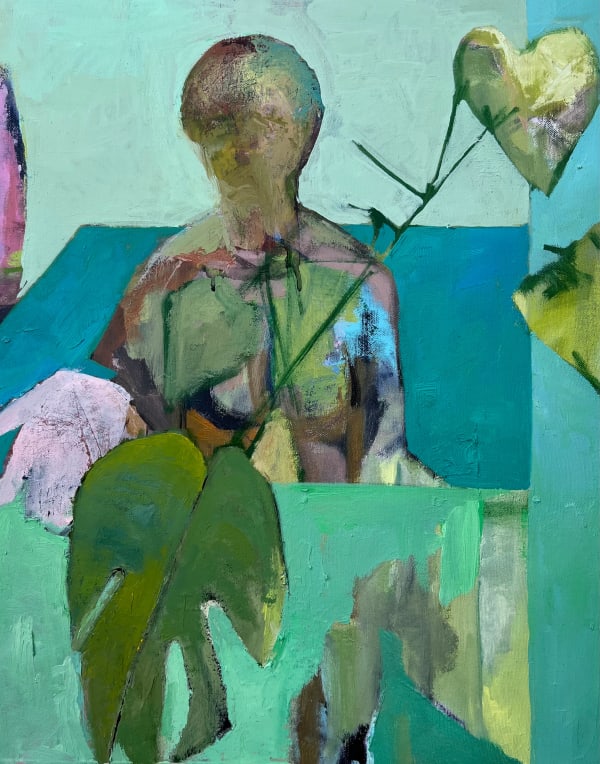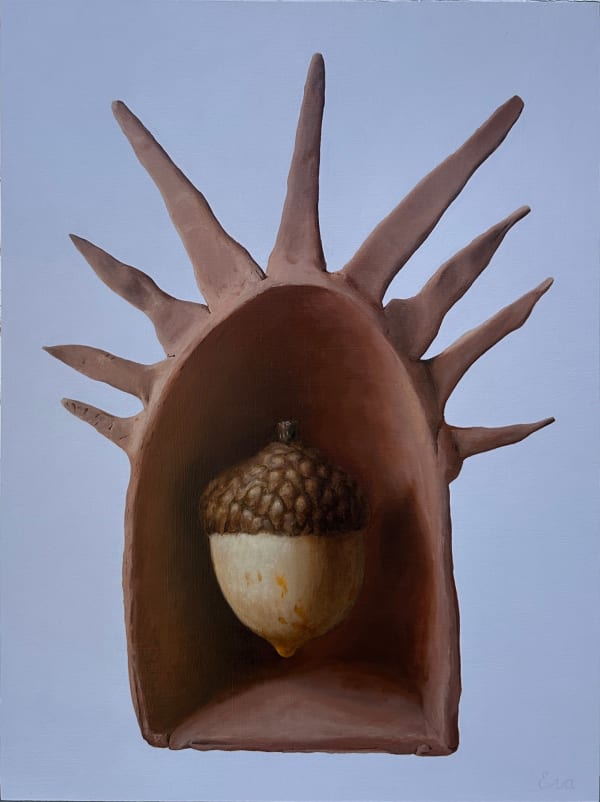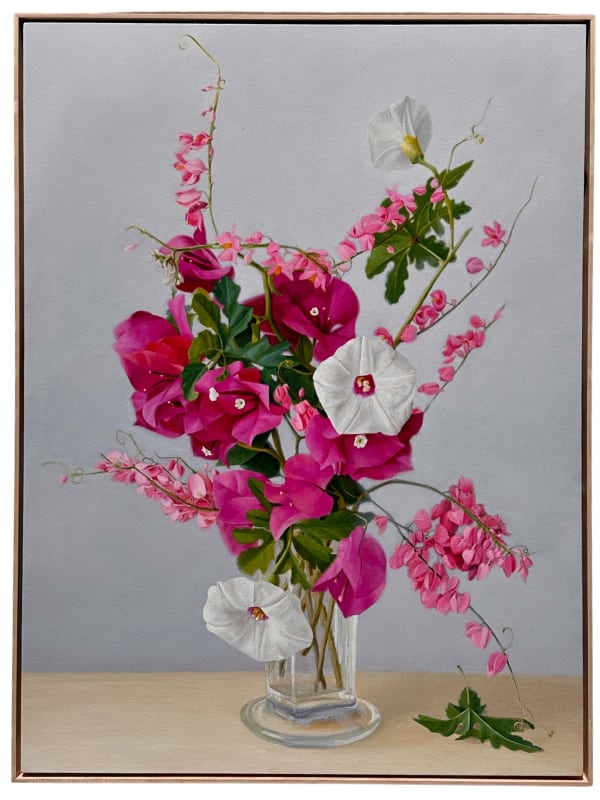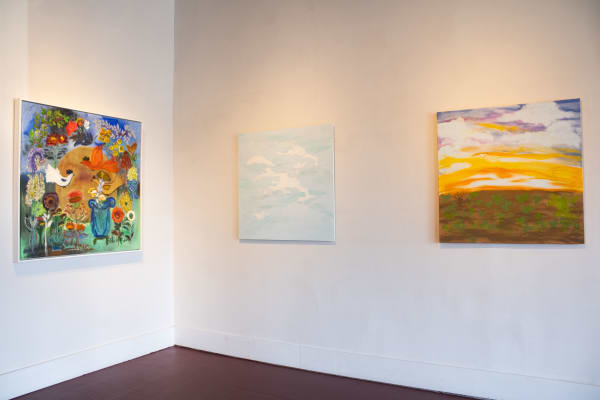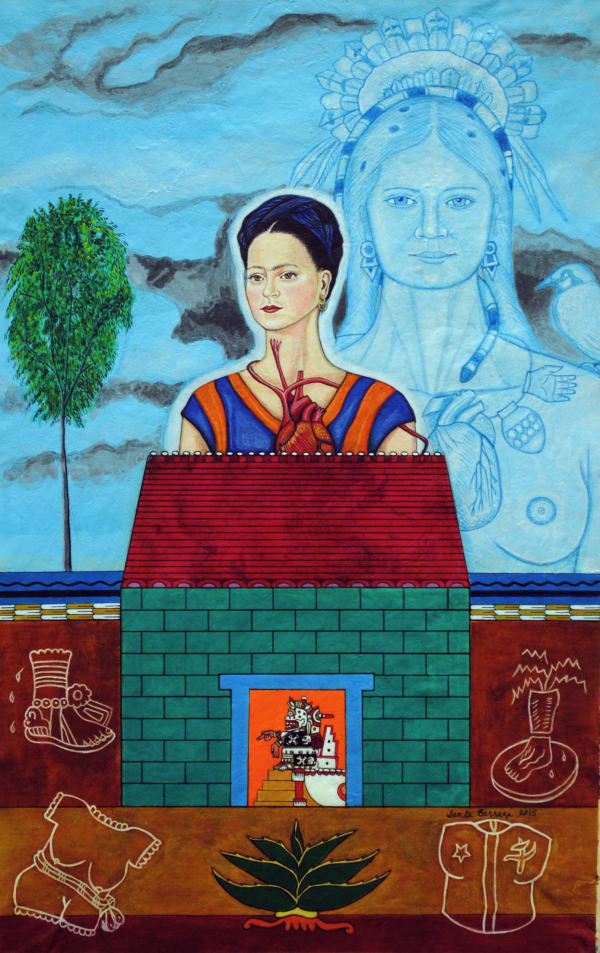Vast and Varied: Texan Women Painters II
Ruiz-Healy Art presents Vast and Varied: Texan Women Painters II, a group exhibition of works by Santa Barraza, Jennifer Agricola Mojica, Audrey Rodríguez, Eva Marengo Sánchez, Marta Sánchez, Ethel Shipton, and Bettie Ward. Vast and Varied: Texan Women Painters II is a continuation of Vast and Varied: Texan Women Painters I, which was on view at our New York City gallery from June 12 to August 15, 2025. The exhibition will be on view at our San Antonio gallery from September 24 to November 1, 2025, with an opening reception on September 24 from 6:00 to 8:00 PM. Vast and Varied: Texan Women Painters II tackles the Texas cultural milieu through themes of cross-cultural identity, motherhood, mementos, and domesticity.
Santa Barraza, a native of Kingsville, Texas, draws on a pre-Hispanic vocabulary, spirituality, folklore, and goddesses. Featured work, Mujeres Nobles Series: Frida con Tezcatlipoca y Coyolxauhqui, illustrates the artist’s ability to synthesize and appropriate historical figures like Frida Kahlo and the Aztec moon goddess Coyolxauhqui, both of whom experienced intense bodily pain. Barraza mirrors Kahlo’s experience with Coyolxauhqui, who was broken into pieces by her brother, Huitzilopochtli, reclaiming and reflecting on their stories as part of a Mestiza identity. Barraza earned her MFA from the University of Texas at Austin. Her work is featured in numerous permanent collections, including the Smithsonian American Art Museum, Washington, D.C.; The National Museum of Print, Mexico City, Mexico; San Antonio Museum of Art, San Antonio, TX; The Blanton Museum of Art, Austin, TX, among others. Barraza was awarded the 2025 Latinx Artist Fellowship, a first-of-its-kind initiative that recognizes 15 of the most compelling Latinx visual artists working in the United States today.
San Antonio-based artist Jennifer Agricola Mojica creates vibrant, ephemeral spaces that offer a sense of belonging in a discordant world. Her superimposed compositions cross genres of abstraction and figurative painting. By stripping and rebuilding thick layers of paint, Agricola Mojica creates visual tensions through fragmented forms that allude to fractured memory, the transience of time, grief, and motherhood. Agricola Mojica states, “as I navigate my life and the lives of my two children, I find myself in a place of constant learning permeated with challenges. These uncomfortable but beautiful experiences punctuate my compositional space. Houses, birds, and figures are frequent motifs that straddle the line between realism and abstraction.” Agricola Mojica has exhibited nationally and internationally, including at the Royal Nebeker Art Gallery in Astoria, OR, and the IF Gallery, Prague, Czech Republic. Her work has been featured in multiple publications, including New Visionary Magazine, Women United Art Magazine, and Art Seen.
Artist Audrey Rodríguez assembles objects of personal and social significance that she pulls from familial settings. Her observational still lifes, which are rooted in cross-cultural identity, primarily explore food, enabling her work to reflect intergenerational attitudes towards migration and the circulation of objects and goods across borders. Rodriguez states, “Many of the objects in my paintings come from my own home or studio—they’re everyday things, but they carry weight. Some items reflect care and permanence, like handmade ceramics passed down or found at markets, while others—plastic bottles, to-go cups—speak to convenience, movement, or economic necessity.” Rodríguez earned her MFA from the New York Academy of Art in 2022 and was awarded the 2023 Chubb Post-Graduate Fellowship. Her painting Corona Plaza (2021) was featured in the Museum of the City of New York’s exhibition, Food in New York: Bigger Than the Plate. Rodríguez’s work has also been included in the Peto Biennial at the John F. Peto Studio Museum. In 2023, she exhibited in Friends & Lovers at the FLAG Art Foundation, New York, NY.
Eva Marengo Sánchez paints realistic still lifes of seemingly mundane subjects. The paintings displayed in the exhibition celebrate her cultural heritage and document her upbringing in San Antonio, Texas. Marengo Sánchez captures snapshots of life to reveal the complex emotional experiences of memory, nostalgia, and loss. Recent institutional exhibitions include the McNay Art Museum, where her work was acquired for the permanent collection, and Centro de Artes, both in San Antonio; the Cheech Marin Center for Chicano Art & Culture in Riverside, California; and the Museo de Arte Querétaro in Querétaro, Mexico. Sanchez has completed multiple public art murals in her hometown, including installations at San Antonio International Airport and the Blue Star Arts Complex.
Born and raised in San Antonio, Texas, Chicana artist Marta Sánchez constructs a cultural identity portrait by merging everyday life scenes with traditional Mexican folkloric expression. Sanchez often paints on aluminum, following in the tradition of Mexican retablos, wherein images and text work harmoniously as a direct way of storytelling. Collecting and documenting narrative, family histories, and migration serves as a way to celebrate heritage, as seen in her painting El Jardin, which serves as a memorial for her grandmother, Blanca Estela. For over forty years, Marta Sanchez has collaborated with artists, poets, cultural organizations, and museums in Philadelphia, where she is based, and beyond. Her work is in prestigious collections such as The Cheech Marin Center for Chicano Art & Culture, Riverside, CA, The Philadelphia Museum of Art, Philadelphia, PA, Smithsonian’s National Museum of the American Latino, Washington D.C., El Museo del Barrio, New York, NY, National Museum of Mexican Art, Chicago, IL, The McNay Art Museum, San Antonio, TX, Woodmere Art Museum, Philadelphia, PA, Art Museum of South Texas, Corpus Christi, TX, among others. Sanchez earned an MFA in Painting from Temple University, Philadelphia, in 1986, and has resided there ever since.
Ethel Shipton, born and raised in Laredo, Texas, documents images from text, language, signs, and urban scenes seen on the street, repurposing them into sculptures, screenprints, and paintings. Shipton grew up in a border town during a time when traveling between the USA and Mexico was more open, allowing her to experience multiple cultures through frequent movement back and forth across the international bridge. “My practice has been about looking at the things around us, maybe even the things that you don’t realize, are speaking to you.” Shipton’s work has been featured in solo and group exhibitions at venues including the Inaugural Exhibition of Ruby City, San Antonio, TX; Artpace, San Antonio, TX; McNay Art Museum, San Antonio, TX; McKinney Contemporary Art Center, Dallas, TX; Sala Diaz, San Antonio, TX; The Center for Curatorial Studies, Bard College, Annandale-on-Hudson, NY.
Bettie Ward is a painter and educator from San Antonio, Texas. Born into a family of Texas ranchers and pioneers, the prairie landscapes of Texas and New Mexico heavily influence her artistic aesthetic. Ward’s personal experiences as a single mother and philanthropist inform the themes found in her artwork, such as communication, growth, romance, personal relationships, and the cyclical nature of humanity. In 2010, Ward moved to Santa Fe, New Mexico, where she lives and works today. Flowers are a recurring motif in Ward’s work, reflecting her admiration for the prairie blooms of Texas and New Mexico, serving as a symbol for decay, transformation, perseverance, and the interconnectivity between humans and nature. Raised on a Texas ranch, her early life immersed her in the wilderness of the American West. This upbringing led her to view plants and animals as analogies for the inherent marvels of human life. She holds a Bachelor of Fine Arts in Sculpture from the San Antonio Art Institute and has studied craft extensively in Mexico and the American Southwest. The artist is in the permanent collections of the San Antonio Museum of Art, San Antonio, TX; McNay Art Museum, San Antonio, TX; Ruby City, San Antonio, TX; and the University of Texas at San Antonio, San Antonio, TX.
-
 Santa BarrazaMujeres Nobles Series: Codex of Maternal Abuelos with Cortez as Richard King, 2024Acrylic on amate paper with attached metal amulet11 x 14.5 in
Santa BarrazaMujeres Nobles Series: Codex of Maternal Abuelos with Cortez as Richard King, 2024Acrylic on amate paper with attached metal amulet11 x 14.5 in
27.9 x 36.8 cm -
 Santa BarrazaMujeres Nobles Series: Frida con Tezcatlipoca y Coyolxauhqui, 2015Acrylic on amate paper23 x 15 in
Santa BarrazaMujeres Nobles Series: Frida con Tezcatlipoca y Coyolxauhqui, 2015Acrylic on amate paper23 x 15 in
58.4 x 38.1 cm -
 Santa BarrazaTorso Series: La Guadalupana with Holy Spirit and Exposed Heart, 2024Acrylic on canvas12 x 12 in
Santa BarrazaTorso Series: La Guadalupana with Holy Spirit and Exposed Heart, 2024Acrylic on canvas12 x 12 in
30.5 x 30.5 cm -
 Marta SánchezEl Jardin, 1998Oil and enamel on aluminum36 x 36 in
Marta SánchezEl Jardin, 1998Oil and enamel on aluminum36 x 36 in
91.4 x 91.4 cm -
 Bettie WardSwoon and Coo, 2025Oil and gold leaf on canvas40 x 40 in
Bettie WardSwoon and Coo, 2025Oil and gold leaf on canvas40 x 40 in
101.6 x 101.6 cm -
 Marta SánchezBlanca Estela’s paradise, 2020Oil on Masonite24 x 24 in
Marta SánchezBlanca Estela’s paradise, 2020Oil on Masonite24 x 24 in
61 x 61 cm -
 Audrey RodriguezFormal Inquiry in Blue and Green (Don't worry the red liquid is chamoy), 2025Oil on linen12 x 16 in
Audrey RodriguezFormal Inquiry in Blue and Green (Don't worry the red liquid is chamoy), 2025Oil on linen12 x 16 in
30.5 x 40.6 cm -
 Audrey RodriguezAunque la mona se vista de seda, mona se queda, 2025Vinyl paint and oil on linen17 x 21 in
Audrey RodriguezAunque la mona se vista de seda, mona se queda, 2025Vinyl paint and oil on linen17 x 21 in
43.2 x 53.3 cm -
 Audrey RodriguezFormal Inquiry in Yellow and Orange, 2025Vinyl paint and oil on linen12 x 16 in
Audrey RodriguezFormal Inquiry in Yellow and Orange, 2025Vinyl paint and oil on linen12 x 16 in
30.5 x 40.6 cm -
 Ethel ShiptonLook for the Joy, 2025House paint on panel36 x 36 in
Ethel ShiptonLook for the Joy, 2025House paint on panel36 x 36 in
91.4 x 91.4 cm -
 Ethel ShiptonLook for the Time, 2025House paint on panel36 x 36 in
Ethel ShiptonLook for the Time, 2025House paint on panel36 x 36 in
91.4 x 91.4 cm -
 Jennifer Agricola MojicaAlone for a Bit, 2025Oil on canvas30 x 40 in
Jennifer Agricola MojicaAlone for a Bit, 2025Oil on canvas30 x 40 in
76.2 x 101.6 cm -
 Jennifer Agricola MojicaFebruary Dreams, 2025Oil on Canvas20 x 16 in
Jennifer Agricola MojicaFebruary Dreams, 2025Oil on Canvas20 x 16 in
50.8 x 40.6 cm -
 Eva Marengo SanchezSonya Renee Taylor, On Radical Self Love, 2025Oil on panel24 x 18 in
Eva Marengo SanchezSonya Renee Taylor, On Radical Self Love, 2025Oil on panel24 x 18 in
61 x 45.7 cm -
 Eva Marengo SanchezJuly: Alamo Vine (native), Bougainvillea (not native), Coral Vine (invasive), 2025Oil on canvas40 x 30 in
Eva Marengo SanchezJuly: Alamo Vine (native), Bougainvillea (not native), Coral Vine (invasive), 2025Oil on canvas40 x 30 in
101.6 x 76.2 cm

